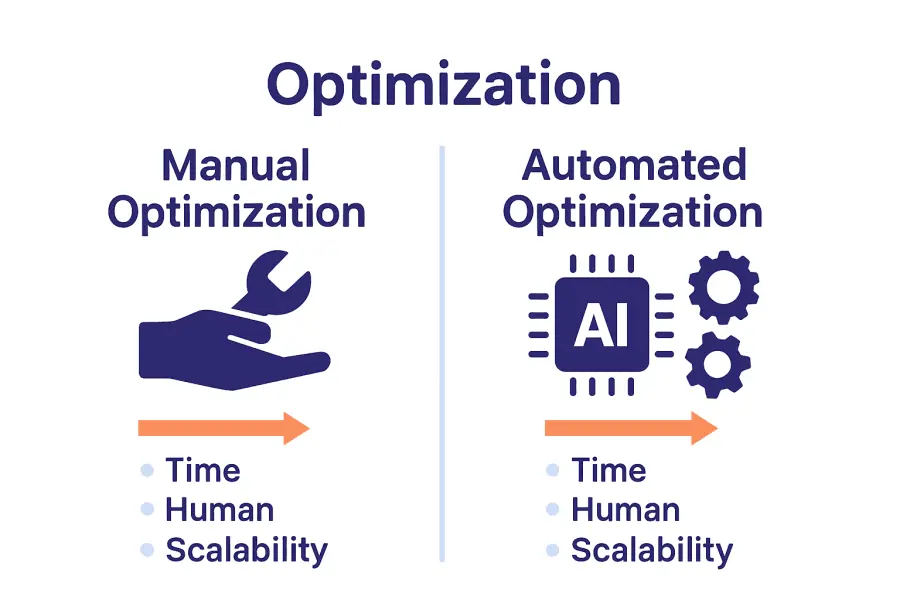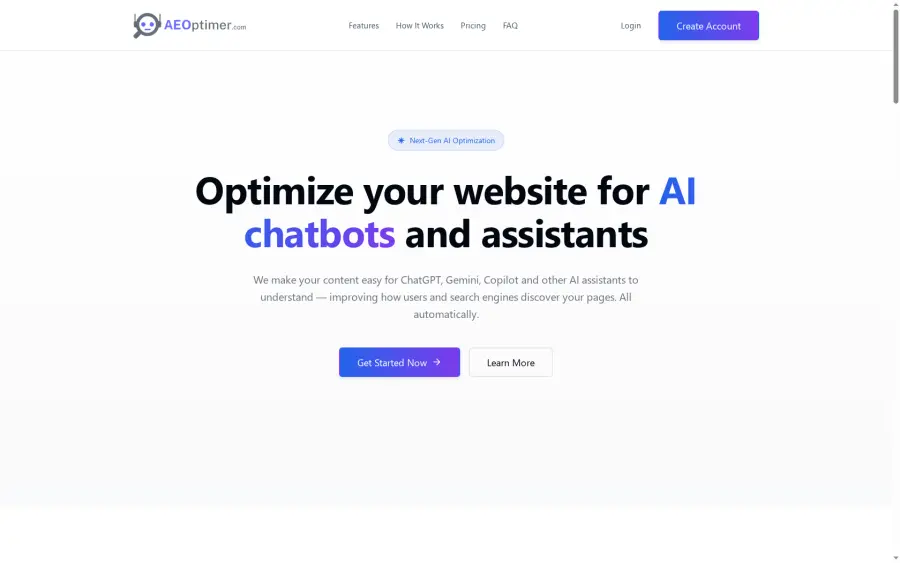Defining Automated Website Optimization: Complete Guide

Over 80 percent of online traffic flows to websites that rank on the first page of search results. Staying ahead is no longer about manual tweaks or guesswork. Automated website optimization now uses advanced AI to adjust sites in real time, maximizing visibility and performance without the need for constant human oversight. Discover how this new approach empowers businesses to keep their websites competitive, efficient, and ready for the future of digital interaction.
Table of Contents
- What Is Automated Website Optimization?
- Types of Automated Optimization Tools
- How Automated Website Enhancements Work
- Essential Features and AI Discoverability
- Costs, Risks, and Limitations to Consider
Key Takeaways
| Point | Details |
|---|---|
| Automated Optimization Overview | Automated website optimization uses AI and machine learning to enhance website performance without manual input, dynamically adapting to user interactions. |
| Core Components | Key elements include continuous content analysis, real-time performance monitoring, AI-driven recommendations, and automatic structured data implementation. |
| Types of Tools | Diverse tools exist, such as performance analyzers and SEO enhancement platforms, each providing intelligent, real-time improvements across multiple dimensions. |
| Risks and Considerations | Businesses should be wary of over-optimization penalties, data privacy concerns, and the complexity in implementing advanced technologies to ensure effective optimization. |
What Is Automated Website Optimization?
Automated website optimization is a sophisticated digital strategy that leverages artificial intelligence and machine learning to continuously improve website performance, visibility, and user experience without manual intervention. Unlike traditional optimization methods that require constant human monitoring, this approach uses advanced algorithms to dynamically scan, analyze, and enhance web pages in real time.
According to Wikipedia, an adaptive website can “adjust its structure, content, or presentation in response to user interactions” with the ultimate goal of optimizing future user experiences. This definition perfectly encapsulates the core principle of automated website optimization: creating intelligent systems that learn and adapt automatically.
The key components of automated website optimization typically include:
- Continuous Content Analysis: Automatic scanning of website content for SEO performance, readability, and relevance
- Technical Performance Monitoring: Real-time tracking of page speed, mobile responsiveness, and technical health
- AI-Driven Recommendations: Intelligent suggestions for improving website elements based on current search trends and user behavior
- Automatic Structured Data Implementation: Seamless addition of schema markup to enhance search engine discoverability
Modern automated optimization goes beyond traditional techniques by incorporating machine learning algorithms that can predict and proactively address potential performance issues. Wikipedia’s entry on web crawling highlights how advanced tools can now simultaneously scan websites for multiple quality factors, including “accessibility, browser compatibility, broken links, legal compliance, search optimization, usability, and web standards compliance”.
By embracing automated website optimization, businesses can ensure their online presence remains dynamic, competitive, and consistently aligned with the latest digital standards. Learn more about the role of automation in website optimization to understand how these intelligent systems are transforming digital strategy.
Types of Automated Optimization Tools
Automated website optimization tools are diverse and sophisticated, ranging from comprehensive performance analyzers to specialized SEO enhancement platforms. These tools leverage advanced algorithms and machine learning to provide intelligent, real-time improvements across multiple digital performance dimensions.
Lighthouse), an open-source tool developed by Google, represents a prime example of automated optimization technology. It “audits performance, accessibility, and search engine optimization factors,” providing deep insights that go beyond traditional metrics. This type of tool exemplifies how modern optimization platforms can comprehensively evaluate and suggest improvements for web properties.
The primary categories of automated optimization tools include:
- Performance Analyzers: Tools that evaluate website speed, responsiveness, and technical infrastructure
- SEO Enhancement Platforms: Systems that automatically optimize content, metadata, and structural elements for search discoverability
- AI-Driven Content Optimization Tools: Intelligent systems that analyze and suggest improvements for readability, keyword usage, and content quality
- Accessibility and Compliance Scanners: Automated tools that ensure websites meet legal and technical standards
SortSite, another advanced web crawler, demonstrates the complexity of modern optimization tools by simultaneously scanning websites for multiple quality factors, “including accessibility, browser compatibility, broken links, legal compliance, search optimization, usability, and web standards compliance”.
Understanding the nuanced landscape of website optimization tools is crucial for businesses seeking to maintain a competitive digital presence. These automated solutions transform what was once a labor-intensive process into a streamlined, intelligent approach to continuous website improvement.

How Automated Website Enhancements Work
Automated website enhancements operate through a complex, intelligent system that continuously monitors, analyzes, and improves web properties without constant human intervention. These sophisticated platforms leverage advanced algorithms and machine learning to create dynamic, responsive digital experiences that adapt in real time.
According to Wikipedia, an adaptive website “adjusts its structure, content, or presentation in response to user interactions” by “building models of user activity and modifying information accordingly”. This fundamental principle underlies the entire automated enhancement ecosystem, transforming static websites into intelligent, self-optimizing platforms.
The core workflow of automated website enhancements typically involves multiple sophisticated stages:
- Continuous Scanning: Automated tools continuously crawl and analyze entire website structures
- Performance Analysis: Detailed assessment of technical performance, content quality, and user experience metrics
- Intelligent Recommendations: Machine learning algorithms generate specific, actionable improvement suggestions
- Automatic Implementation: Seamless application of recommended changes without manual intervention
SortSite, an advanced web crawler, exemplifies the complexity of these systems by simultaneously scanning websites for “accessibility, browser compatibility, broken links, legal compliance, search optimization, usability, and web standards compliance”.
As websites become increasingly complex, understanding AI assistants and their role in website optimization has become crucial for businesses seeking to maintain a competitive digital presence. These automated enhancement technologies represent a paradigm shift from manual optimization to intelligent, proactive digital management.
Essential Features and AI Discoverability
AI discoverability represents a critical frontier in digital marketing, transforming how websites communicate and present information to intelligent search systems and AI assistants. Modern websites must go beyond traditional SEO strategies, creating content that is not just human-readable but also optimized for machine comprehension and interaction.
Writesonic, an advanced AI visibility platform, exemplifies the emerging field of Generative Engine Optimization (GEO), which focuses on helping enterprises understand and improve their representation in AI-generated search and answer systems. This approach represents a fundamental shift in how digital content is conceived and structured.
The essential features for achieving robust AI discoverability include:
- Structured Data Implementation: Adding comprehensive schema markup that helps AI systems understand content context
- Semantic Content Optimization: Creating clear, concise content with logical information hierarchy
- Multilingual and Multimodal Compatibility: Ensuring content can be interpreted across different languages and formats
- Dynamic Content Adaptation: Allowing websites to modify content based on user interactions and AI feedback
According to Wikipedia’s adaptive website research, successful platforms “adjust their structure, content, or presentation in response to user interactions” by “building models of user activity and modifying information accordingly”. This adaptive approach is crucial for maintaining relevance in an AI-driven digital ecosystem.

Learn more about implementing content discoverability strategies for AI to ensure your digital presence remains competitive and intelligible to emerging AI technologies.
Costs, Risks, and Limitations to Consider
Automated website optimization, while powerful, is not without its potential drawbacks and challenges. Businesses must carefully evaluate the complex landscape of technological investment, potential risks, and strategic implementation to ensure meaningful returns on their optimization efforts.
The digital optimization ecosystem contains numerous potential pitfalls that can negatively impact website performance. Wikipedia’s research on link farms illustrates one such risk, highlighting how manipulative optimization strategies like creating “groups of websites that hyperlink to each other to increase SEO rankings” can actually result in search engine penalties, demonstrating that not all optimization approaches are beneficial.
Key risks and limitations in automated website optimization include:
- Over-Optimization Penalties: Search engines may downgrade websites that appear to be artificially manipulating content or structure
- Privacy and Data Collection Concerns: Automated tools might collect and process user data in ways that raise ethical and legal questions
- Technical Complexity: Implementing advanced optimization strategies requires significant technical expertise
- Potential Algorithm Misalignment: Automated systems might not perfectly interpret context or nuanced content
XRumer, a controversial software designed for automated online interactions, serves as a cautionary example of how optimization tools can potentially be misused, demonstrating the critical importance of selecting reputable and ethical optimization platforms.
Learn more about monthly website optimization steps for maintaining AI discoverability to develop a balanced, strategic approach to digital enhancement.
Transform Your Website with Automated Optimization
Struggling to keep your website aligned with constantly evolving AI-driven search and digital trends? The challenge of continuous scanning, intelligent content updating, and structured data implementation described in the article is hard to manage without technical expertise or dedicated resources. If you want to avoid the risks of outdated SEO, missed AI discoverability opportunities, and manual guesswork in optimization, a powerful automated solution can make all the difference.

Experience how aeoptimer.com effortlessly enhances your website’s visibility for AI assistants and search engines. By simply adding a small script, you enable automatic monthly crawling, analysis, and updates that keep your content truly AI-friendly without altering your site’s appearance or requiring complex technical work. Don’t wait until your site falls behind in AI discoverability and search rankings. Take control now and see how easy it is to stay ahead with ongoing, seamless optimization. Visit aeoptimer.com and empower your website to adapt with the future of digital search.
Frequently Asked Questions
What is automated website optimization?
Automated website optimization utilizes artificial intelligence and machine learning to enhance website performance, visibility, and user experience automatically, reducing the need for manual intervention.
How do automated website optimization tools work?
These tools continuously scan, analyze, and improve website elements by providing intelligent, real-time recommendations and automatically implementing changes without human oversight.
What are the key benefits of using automated website optimization?
The benefits include improved website performance, enhanced user experience, real-time adjustments to SEO and content strategies, and ongoing compliance with digital standards without constant human effort.
What are the risks associated with automated website optimization?
Potential risks include over-optimization penalties from search engines, privacy concerns, technical complexity in implementation, and misinterpretation of nuanced content by automated systems.





